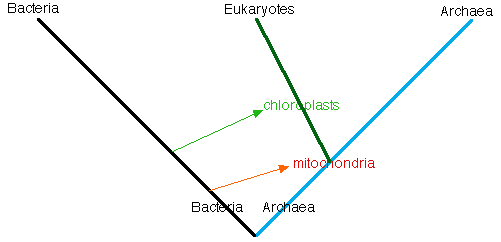When these microscopic organisms were first discovered (in 1977), they were considered bacteria. However, when their ribosomal RNA was sequenced, it became obvious that they bore no close relationship to the bacteria and were, in fact, more closely related to the eukaryotes (including ourselves!) For a time they were referred to as archaebacteria, but now to emphasize their distinctness, we call them Archaea.
Some of the first to be discovered were called Extremophiles in recognition of the extreme environments in which they were found:
- thermophiles, which live at high temperatures;
- hyperthermophiles, which live at really high temperatures (present record is 121°C!);
- psychrophiles, which like it cold (one in the Antarctic grows best at 4°C);
- halophiles, which live in very saline environments (like the Dead Sea);
- acidophiles, which live at low pH (as low as pH 1 and who die at pH 7!);
- alkaliphiles, which thrive at a high pH.
However, several hundred more species have been discovered in recent years and most of these live in "normal" habitats (e.g., ocean waters and sediments). Genomic analysis reveals that they represent a diverse array of species that cluster in more than a dozen different clades. Here I will mention only four of these:
- three groups of Euryarchaeota and the
- Crenarchaeota
Prominent members of this group are the:
- Methanogens
- Halophiles
- Thermoacidophiles
These are found living in such anaerobic environments as
- the muck of swamps and marshes;
- the rumen of cattle (where they live on the hydrogen and CO2 produced by other microbes living along with them);
- our colon (large intestine);
- sewage sludge;
- the gut of termites.
They are chemoautotrophs; using hydrogen as a source of electrons for reducing carbon dioxide to food and giving off methane ("marsh gas", CH4) as a byproduct.
4H2 + CO2 -> CH4 + 2H2O
The first methanogens to have had their complete genomes sequenced were:
- Methanocaldococcus jannaschii and
- Methanothermobacter thermoautotrophicus
[View the data]
These are found in extremely saline environments such as the Great Salt Lake in the U.S. and the Dead Sea. They maintain osmotic balance with their surroundings by building up the solute concentration within their cells.
As their name suggests, these like it hot and acid (but not as hot as some of the Crenarchaeota!). They are found in such places as acidic sulfur springs (e.g., in Yellowstone National Park) and undersea vents ("black smokers").
The first members of this group to be discovered like it really hot and so are called hyperthermophiles. One can grow at 121°C (the same temperature in the autoclaves used to sterilize culture media, surgical instruments, etc.).
Many like it acid as well as hot and live in acidic sulfur springs at a pH as low as 1 (the equivalent of dilute sulfuric acid). These use hydrogen as a source of electrons to reduce sulfur in order to get the energy they need to synthesize their food (from CO2).
The genome of Aeropyrum pernix, a member of the group, is described at this [Link].
Other members of this group seem to make up a large fraction of
- the plankton in cool, marine waters;
- the microbes in both soil and the ocean that convert ammonia into nitrites (nitrification).
The archaea have a curious mix of traits characteristic of
- bacteria as well as traits found in
- eukaryotes
The table summarizes some of them.
| Eukaryotic Traits |
Bacterial Traits |
|
|
|

- Many traits found in the bacteria first appeared in the ancestors of all the present-day groups.
- The split leading to the archaea and the eukaryotes occurred after the bacteria had gone their own way.
- However, the acquisition by eukaryotes of
occurred after their line had diverged from the archaea.
Because they have enzymes that can function at high temperatures, considerable effort is being made to exploit the archaea for commercial processes such as providing
- enzymes to be added to detergents (maintain their activity at high temperatures and pH);
- an enzyme to covert corn starch into dextrins.
Archaea may also be enlisted to aid in cleaning up contaminated sites, e.g., petroleum spills.
4 February 2023
